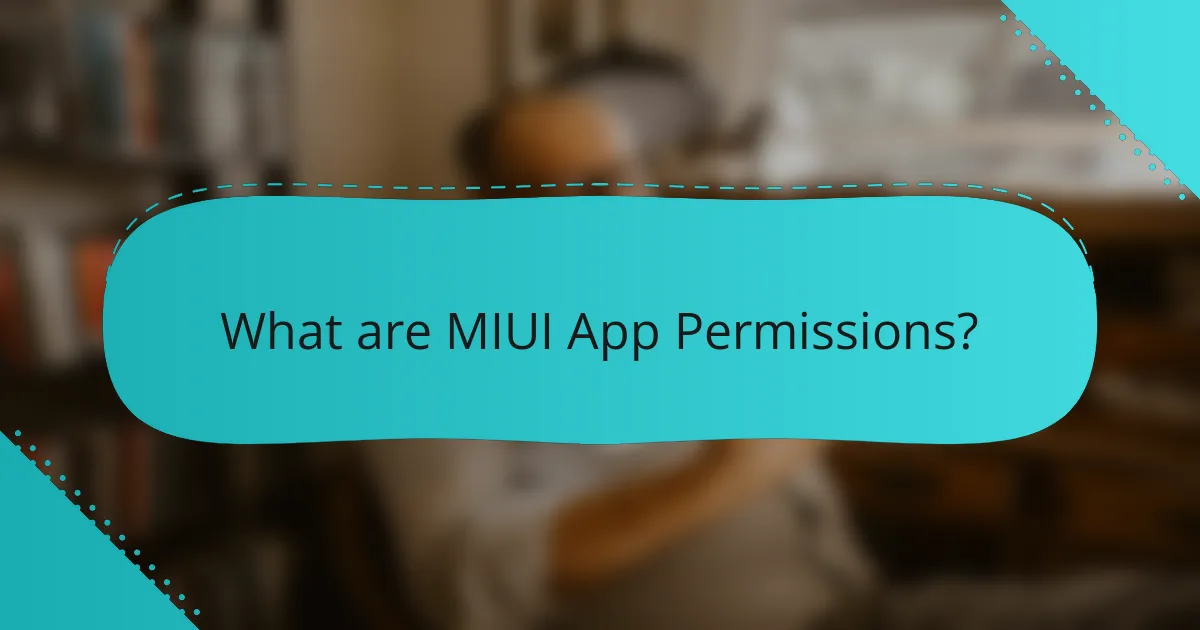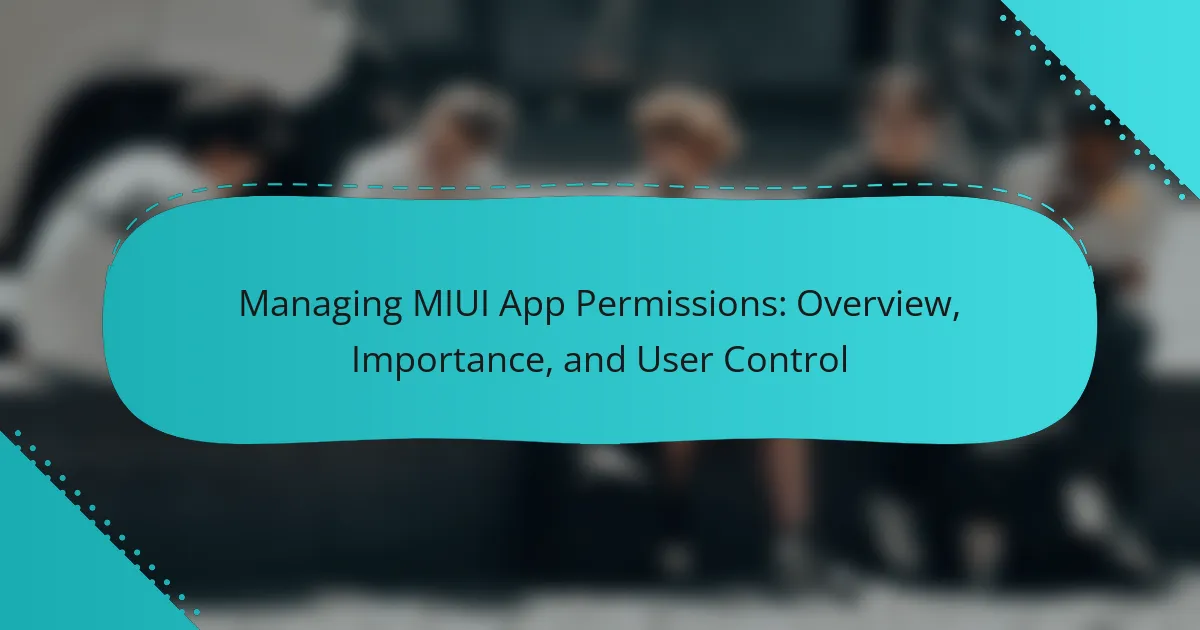
What are MIUI App Permissions?
MIUI App Permissions are the specific access rights granted to applications on MIUI devices. These permissions control how apps interact with device features like the camera, microphone, and location services. Users can manage these permissions to enhance privacy and security. MIUI provides a user-friendly interface for adjusting app permissions. This allows users to grant or revoke access as needed. The system ensures that apps only use permissions essential for their functionality. MIUI also notifies users when an app attempts to access sensitive data. This promotes transparency and user control over personal information.
How do MIUI App Permissions function within the system?
MIUI App Permissions function by controlling access to sensitive features on the device. Each app requests specific permissions upon installation or during use. Users can grant or deny these permissions based on their preferences. The MIUI system categorizes permissions into groups, such as location, camera, and storage. Users can manage permissions through the settings menu. This management helps protect user privacy and device security. MIUI also provides notifications for apps that request permissions. Users can review and modify permissions at any time. This ensures that apps only access necessary features, enhancing overall user control.
What types of permissions are available in MIUI?
MIUI offers several types of permissions for apps. These include storage permissions, location permissions, camera permissions, and microphone permissions. Storage permissions allow apps to read and write files. Location permissions enable apps to access the device’s geographical location. Camera permissions allow apps to capture photos and videos. Microphone permissions enable apps to record audio. Each permission type can be managed individually in the MIUI settings. This granularity helps users control their privacy and security effectively.
How are permissions categorized in MIUI?
Permissions in MIUI are categorized into four main groups: Normal, Dangerous, Signature, and Special. Normal permissions involve low-risk actions, such as accessing the internet. Dangerous permissions require user approval due to potential privacy risks, like accessing location data. Signature permissions are granted to apps signed with the same certificate, allowing them to share data securely. Special permissions are unique and may include settings like displaying over other apps. This categorization helps users manage app access effectively while maintaining security and privacy.
Why is managing MIUI App Permissions important?
Managing MIUI App Permissions is important for user privacy and device security. Proper management prevents unauthorized access to sensitive data. Apps often request permissions that may not be necessary for their functionality. For instance, a flashlight app should not need access to contacts or location. By controlling permissions, users can minimize risks of data breaches. Studies show that 85% of users are unaware of app permissions they grant. This lack of awareness can lead to misuse of personal information. Therefore, managing these permissions is essential for maintaining control over personal data.
What security benefits come from managing these permissions?
Managing app permissions enhances security by restricting access to sensitive data. This minimizes the risk of unauthorized data exposure. Users can control which apps access their location, contacts, or storage. Limiting permissions reduces the attack surface for malicious software. Studies show that apps with fewer permissions are less likely to be exploited. Regularly reviewing permissions helps identify potentially harmful apps. Proper management also fosters user trust in the app ecosystem. Overall, effective permission management is crucial for maintaining data privacy and security.
How does managing permissions enhance user privacy?
Managing permissions enhances user privacy by allowing users to control access to their personal information. When users manage permissions, they can restrict apps from accessing sensitive data. This includes location, contacts, and messages. By limiting access, users reduce the risk of unauthorized data collection. Research shows that 70% of users feel more secure when they control app permissions. Furthermore, controlling permissions helps prevent data breaches and misuse of information. Ultimately, managing permissions empowers users to protect their privacy effectively.
How can users control MIUI App Permissions effectively?
Users can control MIUI app permissions effectively by accessing the settings menu. They should navigate to “Settings” and then select “Apps.” Within this section, users can find “App permissions.” Here, they can view all installed apps and their respective permissions. Users can toggle permissions on or off for each app as needed. This allows for granular control over what data and features apps can access. Regularly reviewing these permissions helps enhance privacy and security. MIUI also provides notifications when apps request new permissions, allowing users to make informed decisions.
What steps should users follow to access permission settings?
To access permission settings, users should open the device’s Settings app. Next, they need to scroll down and select ‘Apps’. After that, users should choose ‘Manage Apps’ to view the list of installed applications. They can then select a specific app to view its permissions. Finally, users can tap on ‘Permissions’ to modify the settings as needed. This process allows users to control app access to various device features.
How can users customize permissions for individual apps?
Users can customize permissions for individual apps through the settings menu on their device. They should navigate to the ‘Apps’ section in the settings. From there, users can select the specific app they wish to modify. Each app will display its current permissions. Users can toggle permissions on or off according to their preferences. This allows control over access to features like the camera, microphone, and location. Customizing permissions enhances user privacy and security. MIUI provides a straightforward interface for managing these settings effectively.
What challenges might users face in managing MIUI App Permissions?
Users may face several challenges in managing MIUI App permissions. One major challenge is the complexity of the permission settings interface. Users often find it difficult to navigate through multiple layers of settings. This can lead to confusion about which permissions are necessary for specific apps. Another challenge is the lack of clear explanations for each permission request. Users may not understand why an app needs certain permissions, leading to hesitance in granting them. Additionally, users may encounter issues with permissions reverting after updates. This can disrupt app functionality and user experience. Lastly, some users may struggle with the implications of granting permissions on privacy and security. This can create anxiety about data safety and app behavior.
How can users troubleshoot permission-related issues?
Users can troubleshoot permission-related issues by checking app settings and system permissions. They should navigate to the device settings and locate the app in question. Once found, users can view the permissions granted to the app. If permissions are restricted, they can enable the necessary permissions. Additionally, users should ensure that the device is updated to the latest software version. Outdated software can lead to permission conflicts. Restarting the device can also resolve temporary glitches affecting permissions. If issues persist, users may consider reinstalling the app to reset its permissions.
What common mistakes should users avoid when managing permissions?
Common mistakes users should avoid when managing permissions include granting excessive permissions unnecessarily. Users often approve all requested permissions without evaluating their necessity. This can lead to privacy risks and data exposure. Another mistake is ignoring permission requests from apps. Users should assess each request based on the app’s functionality. Additionally, failing to regularly review and update permission settings is common. Regular checks can help maintain security and privacy. Users should also overlook app permissions after uninstallation. Deleting apps does not always revoke permissions, which can leave residual access. Lastly, not understanding the implications of permissions can lead to misuse. Awareness of what each permission entails is crucial for informed decision-making.
What best practices should users follow for managing MIUI App Permissions?
Users should regularly review and adjust MIUI app permissions. Start by accessing the settings menu and selecting ‘Apps’. From there, choose ‘Permissions’ to view the permissions granted to each app. Limit permissions to only what is necessary for the app’s functionality. For instance, a photo editing app does not need access to your contacts. Additionally, users should revoke permissions for apps that are rarely used. This enhances privacy and security. Regular updates to MIUI can also improve permission management features. Always check for the latest version to utilize enhanced controls.
Managing MIUI App Permissions is essential for controlling access rights granted to applications on MIUI devices, impacting user privacy and security. The article outlines how these permissions function, their types, and the importance of managing them effectively to prevent unauthorized access to sensitive data. It also discusses the categorization of permissions, challenges users may face, troubleshooting tips, and best practices for maintaining control over app access. By understanding and managing these permissions, users can enhance their overall device security and protect their personal information.
